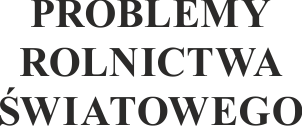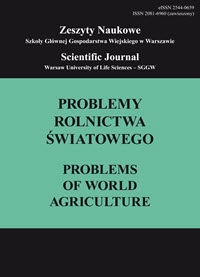Main Article Content
Article Details
Aiginger, K. (1998). A framework for evaluating the dynamic competitiveness of countries. Structural Change and Economic Dynamics, 9(2), 159-188. DOI: 10.1016/S0954-349X(97)00026-X. (Crossref)
Agriculture and Agri-Food Canada. Pobrane 2 czerwca 2018 z: http://www.agr.gc.ca/eng/industry-markets-and-trade/statistics-and-market-information/?id=1361289956531.
Devine, P. (1996). Competitiveness and the Objectives of Communities. W: P. Devine, Y. Katsoulacos, R. Sugden (red.) Competitiveness, Subsidiarity and Industrial Policy (s. 1-11). London, New York: Routledge.
EUROSTAT. Annual detailed enterprise statistics – industry and construction. Pobrane 2 czerwca 2018 z: http://ec.europa.eu/eurostat/data/database.
Fagerberg, J. (1996). Technology and Competitiveness. Oxford Review of Economic Policy, 12(3), 39-51. DOI: 10.1093/oxrep/12.3.39. (Crossref)
Fagerberg, J. (1997). Competitiveness, scale and R&D. W: J. Fagerberg, P. Hansson, L. Lundberg, A. Melchior (red.) Technology and International Trade (s. 38-54). Cheltenham: Edward Elgar Publishing Limited.
Fagerberg, J., Knell, M., Srholec, M. (2004). The competitiveness of Nations: Economic Growth in the ECE Region. Economic Survey of Europe, 2, 51-66.
Fischer, Ch., Schornberg, S. (2007). Assessing the Competitiveness Situation of EU Food and Drink Manufacturing Industries: An Index-Based Approach. Agribusiness, 23(4), 473-495. (Crossref)
Frohberg, K., Hartmann, M. (1997). Comparing Measures of Competitiveness. Discussion Paper No. 2. Halle: IAMO.
Global Agricultural Trade System. Pobrane 6 czerwca 2018 z: https://apps.fas.usda.gov/gats/ExpressQuery1.aspx
Gradziuk, A., Kugiel, P. (red.). (2012). Polska w wielobiegunowym świecie. Szanse i perspektywy rozwoju stosunków Polski z głównymi mocarstwami wschodzącymi (Poland in a multipolar world. Opportunities and prospects for the development of Poland's relations with the main emerging powers). Raport Polskiego Instytutu Spraw Międzynarodowych. Warszawa: PISM.
Jagiełło, E.M. (2008). Strategiczne budowanie konkurencyjności gospodarki (Strategic building of competitiveness of the economy). Warszawa: Wydawnictwo Poltext.
Kennedy, P.L., Harrison, R.W., Kalaitzandonakes, N.G., Peterson, H.Ch., Rindfuss, R.P. (1997). Perspectives on Evaluating Competitiveness in Agribusiness Industries. Agribusiness, 13(4), 385-392. (Crossref)
Kiwerska, J. (2018). Nowe problemy w stosunkach transatlantyckich (New problems in transatlantic relations). Biuletyn Instytutu Zachodniego, 340, 1-5.
Krugman, P. (1994). Competitiveness: A Dangerous Obsession. Foreign Affairs, 73(2), 28-44. (Crossref)
Latruffe, L. (2010). Competitiveness, Productivity and Efficiency in the Agricultural and Agri-Food Sectors. OECD Food, Agriculture and Fisheries Working Papers No. 30. Paris: OECD Publishing.
Lubiński, M. (1995). Konkurencyjność gospodarki: pojęcie i sposób mierzenia (Competitiveness of the economy: the concept and measurement). W: M. Lubiński, T. Smuga (red.) Międzynarodowa konkurencyjność gospodarki Polski – uwarunkowania i perspektywy (International competitiveness of the Polish economy – determinants and prospects). Raporty – Studia nad konkurencyjnością. Warszawa: Instytut Rozwoju i Studiów Strategicznych.
Milczarek, D. (2008). Stosunki transatlantyckie w sferze polityki zagranicznej i bezpieczeństwa: kontynuacja czy przełom? Polski punkt widzenia (Transatlantic relations in the area of foreign and security policy: follow-up or break-point? Polish perspective). Studia Europejskie, 2, 31-57.
Nassif, A., Feijo C., Araújo, E. (2016). The BRICS’s Economic Growth Performance before and after the International Financial Crisis. International Journal of Political Economy, 45(4), 294-314. DOI: 10.1080/08911916.2016.1270083. (Crossref)
Nayyar, D. (2016). BRICS, developing countries and global governance. Third World Quarterly, 37(4), 575-591. DOI: 10.1080/01436597.2015.1116365. (Crossref)
Pawlak, K. (2013). Międzynarodowa zdolność konkurencyjna sektora rolno-spożywczego krajów Unii Europejskiej (International competitive capacity of the agri-food sector in the European Union countries). Rozprawy Naukowe, 448. Poznań: Wydawnictwo Uniwersytetu Przyrodniczego w Poznaniu.
Pitts, E., Lagnevik, M. (1998). What determines food industry competitiveness? W: W.B. Traill, E. Pitts (red.) Competitiveness in the food industry (s. 1-34). London: Blackie Academic & Professional.
Poczta, W., Beba, P. (2014). Rola przemysłu spożywczego w gospodarkach krajów UE (The role of the food industry in European Union countries). ZN SGGW Problemy Rolnictwa Światowego, 14(3), 158-167.
Porter, M.E. (1990). The Competitive Advantage of Nations. New York: The Free Press, A Division of Macmillan Inc. (Crossref)
President’s Commission on Industrial Competitiveness (1985). Global Competition: The New Reality. Washington D.C.: U.S. Government Printing Office.
Scott, L., Vollrath, T. (1992). Global Competitive Advantages and Overall Bilateral Complementarity in Agriculture: A Statistical Review. Washington: Economic Research Service, U.S. Department of Agriculture.
Siddiqui, K. (2016). Will the Growth of the BRICs Cause a Shift in the Global Balance of Economic Power in the 21st Century? International Journal of Political Economy, 45(4), 315-338. DOI: 10.1080/08911916.2016.1270084. (Crossref)
Siggel, E. (2006). International competitiveness and comparative advantage: A survey and a proposal for measurement. Journal of Industry, Competition and Trade, 6(2), 137-159. DOI:10.1007/s10842-006-8430-x. (Crossref)
Singh, A. (1977). UK industry and the world economy: a case of de-industrialisation. Cambridge Journal of Economics, 1(2), 113-136. DOI: 10.1093/oxfordjournals.cje.a035354. (Crossref)
Sporek, K., Czech, K. (red.). (2015). Państwa grupy BRICS i ich znaczenie we współczesnej gospodarce światowej (BRICS countries and their importance in the contemporary global economy). Katowice: Wydawnictwo Uniwersytetu Ekonomicznego w Katowicach.
Tereszczuk, M. (2016). Ocena pozycji konkurencyjnej przemysłu spożywczego w Polsce na tle wybranych państw Unii Europejskiej (An assessment of the competitive position of the food industry in Poland against selected European Union countries). W: I. Szczepaniak (red.) Konkurencyjność polskich producentów żywności i jej determinanty (2) (Competitiveness of Polish food producers and its determinants (2)). Raport PW 2015-2019 Nr 38. Warszawa: IERiGŻ-PIB.
The BRICS Report. A Study of Brazil, Russia, India, China, and South Africa with special focus on synergies and complementarities (2012). New Delhi: Oxford University Press.
The US Census Bureau. Annual Survey of Manufactures. Pobrane 9 czerwca 2018 z: http://www.census.gov/ programs-surveys/asm/data/tables.html.
Van Duren, E., Martin, L., Westgren, R. (1991). Assessing the Competitiveness of Canada’s Agrifood Industry. Canadian Journal of Agricultural Economics, 39(4), 727-738. DOI: 10.1111/j.1744-7976.1991.tb03630.x. (Crossref)
Wijnands, J., van Berkum, S., Verhoog, D. (2015). Measuring Competitiveness of Agro-Food Industries: The Swiss Case. OECD Food, Agriculture and Fisheries Papers No. 88. Paris: OECD Publishing.
Wijnands, J.H.M., Bremmers, H.J., van der Meulen, B.M.J., Poppe, K.J. (2008). An economic and legal assessment of the EU food industry's competitiveness. Agribusiness, 24(4), 417-439. (Crossref)
Wijnands, J.H.M., van der Meulen, B.M.J., Poppe, K.J. (2006). Competitiveness of the European food industry. An economic and legal assessment 2007. European Commission Project No. 30777. The Hague: LEI.
Wijnands, J.H.M., Verhoog, D. (2016). Competitiveness of the EU food industry. Ex-post assessment of trade performance embedded in international economic theory. LEI Report 2016-018. Wageningen: LEI Wageningen UR (University & Research Centre). (Crossref)
Zawiślińska, I. (2003). Gospodarka Kanady przełomu wieków. Międzynarodowa pozycja konkurencyjna (Canadian economy at the turn of the century. International competitive position). Warszawa: Oficyna Wydawnicza SGH.
Downloads
- Karolina Pawlak, Walenty Poczta, Handel wewnątrzgałęziowy w wymianie produktami rolno spożywczymi UE z USA , Zeszyty Naukowe SGGW w Warszawie - Problemy Rolnictwa Światowego: Tom 19 Nr 4 (2019)
- Karolina Pawlak, Agnieszka Sapa, Potencjalne skutki utworzenia strefy wolnego handlu UE-MERCOSUR dla handlu rolno-żywnościowego UE , Zeszyty Naukowe SGGW w Warszawie - Problemy Rolnictwa Światowego: Tom 16 Nr 1 (2016)
- Karolina Pawlak, Importance and Comparative Advantages of the EU and US Agri-food Sector in World Trade in 1995-2015 , Zeszyty Naukowe SGGW w Warszawie - Problemy Rolnictwa Światowego: Tom 17 Nr 4 (2017)
- Karolina Pawlak, Zmiany w polskim handlu zagranicznym produktami rolno-spożywczymi po akcesji do Unii Europejskiej , Zeszyty Naukowe SGGW w Warszawie - Problemy Rolnictwa Światowego: Tom 14 Nr 2 (2014)
- Karolina Pawlak, Karolina Sowa, Zmiany w produkcji i handlu soją w Polsce i wybranych krajach UE , Zeszyty Naukowe SGGW w Warszawie - Problemy Rolnictwa Światowego: Tom 20 Nr 3 (2020)
- Karolina Pawlak, Dawid Jabkowski, Przewagi komparatywne USA w eksporcie wybranych surowców roślinnych na Jednolity Rynek Europejski , Zeszyty Naukowe SGGW w Warszawie - Problemy Rolnictwa Światowego: Tom 18 Nr 4 (2018)
- Karolina Pawlak, Znaczenie wymiany bilateralnej w handlu zagranicznym produktami rolno-spożywczymi UE i USA , Zeszyty Naukowe SGGW w Warszawie - Problemy Rolnictwa Światowego: Tom 17 Nr 2 (2017)
- Karolina Pawlak, Bezpośrednie inwestycje zagraniczne w przemyśle spożywczym krajów Unii Europejskiej , Zeszyty Naukowe SGGW w Warszawie - Problemy Rolnictwa Światowego: Tom 16 Nr 2 (2016)
- Karolina Pawlak, Changes in the EU and Global Milk and Dairy Products Market in View of Multilateral Trade Liberalisation , Zeszyty Naukowe SGGW w Warszawie - Problemy Rolnictwa Światowego: Tom 14 Nr 4 (2014)
- Karolina Pawlak, Stan przemysłu spożywczego w Polsce na tle pozostałych krajów UE i USA , Zeszyty Naukowe SGGW w Warszawie - Problemy Rolnictwa Światowego: Tom 16 Nr 3 (2016)

Utwór dostępny jest na licencji Creative Commons Uznanie autorstwa – Użycie niekomercyjne 4.0 Międzynarodowe.





